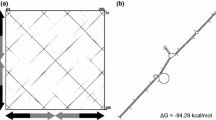Abstract
The maize Mutator ( Mu) system has been described as the most active and mutagenic plant transposon so far discovered. Mu -like elements (MULEs) are widespread among plants, and many and diverse variants can coexist in a particular genome. The autonomous regulatory element MuDR contains two genes: mudrA encodes the transposase, while the function of the mudrB gene product remains unknown. Although mudrA -like sequences are ubiquitous in plants, mudrB seems to be restricted to the genus Zea. In the SUCEST (the Brazilian Sugarcane EST Sequencing Project) database, several mudrA -like cDNAs have been identified, suggesting the presence of a transcriptionally active Mu system in sugarcane. Phylogenetic studies have revealed the presence in plants of four classes of mudrA -like sequences, which arose prior to the monocot/eudicot split. At least three of the four classes are also found in the progenitors of the sugarcane hybrid ( Saccharum spp.), Saccharum officinarum and S. spontaneum. The frequency of putatively functional transposase ORFs varies among the classes, as revealed at both cDNA and genomic levels. The predicted products of some sugarcane mudrA -like transcripts contain both a DNA-binding domain and a transposase catalytic-site motif, supporting the idea that an active Mu system exists in this hybrid genome.





Similar content being viewed by others
References
Altschul SF, Madden TL, Schäffer AA, Zhang J, Zhang Z, Miller W, Lipman DJ (1997) Gapped BLAST and PSI-BLAST: a new generation of protein database search programs. Nucleic Acids Res 25:3389–3402
Benito MI, Walbot V (1997) Characterization of the maize Mutator transposable element MURA transposase as a DNA-binding protein. Mol Cell Biol 17:5165–5175
Chalvet F, Grimaldi C, Kaper F, Langin T, Daboussi MJ (2003) Hop, an active Mutator -like element in the genome of the fungus Fusarium oxysporum. Mol Biol Evol 20:1362–75
D’Hont A, Glaszman JC (2001) Sugarcane genome analysis with molecular markers: a first decade of research. Proc Int Soc Sugarcane Technol 24:556–559
D’Hont A, Grivet L, Feldman P, Rao S, Berding N, Glaszmann JC (1996) Characterization of the double genome structure of modern sugarcane cultivars ( Saccharum spp.) by molecular cytogenetics. Mol Gen Genet 250:405–413
Eisen JA, Benito MI, Walbot V (1994) Sequence similarity of putative transposases links the maize Mutator autonomous elements and a group of bacterial insertion sequences. Nucleic Acids Res 22:2634–2636
Gordon D, Abajian C, Green P (1998) Consed: a graphical tool for sequence finishing. Genome Res 8:195–202
Haren L, Ton-Hoang B, Chandler M (1999) Integrating DNA: transposases and retroviral integrases. Annu Rev Microbiol 53:245–281
Hartl DL, Lohe AR, Lozovskaya ER (1997) Modern thoughts on an ancient Marinere: function, evolution, regulation. Annu Rev Genet 31:337–358
Higgins D, Thompson J, Gibson T, Thompson JD, Higgins DG, Gibson TJ (1994) CLUSTAL W: improving the sensitivity of progressive multiple sequence alignment through sequence weighting, position-specific gap penalties and weight matrix choice. Nucleic Acids Res.22:4673–4680
Hudson ME, Lisch DR, Quail PH (2003) The FHY3 and FAR1 genes encode transposase-related proteins involved in regulation of gene expression by the phytochrome A-signaling pathway. Plant J 34:453 –471
Lisch DR (2002) Mutator transposons. Trends Plant Sci 7:498–504
Lisch DR, Girad L, Donlin M, Freeling M (1999) Functional analysis of deletion derivatives of the maize transposon MuDR delineates roles for the MURA and MURB proteins. Genetics 151:331–341
Lisch DR, Freeling M, Langham RJ, Choy MY (2001) Mutator transposase is widespread in the grasses. Plant Physiol 125:1293–1303
Raizada MN, Walbot V (2000) The late developmental pattern of Mu transposon excision is conferred by a cauliflower mosaic virus 35S-driven MURA cDNA in transgenic maize. Plant Cell 12:5–21
Robertson DS (1978) Characterization of a Mutator system in maize. Mutat Res 51:21–28
Rossi M, Araujo PG, Van Sluys MA (2001) Survey of transposable elements in sugarcane expressed sequence tags (ESTs). Genetics Mol Biol 24:147–154
Rudenko GN, Walbot V (2001) Expression and post-transcriptional regulation of maize transposable elements MuDR and its derivatives. Plant Cell 13:553–570
Rudenko GN, Ono A, Walbot V (2003) Initiation of silencing of maize MuDR/Mu transposable elements. Plant J 33:1013–1025
Saitou N, Nei M (1987) The neighbor-joining method: a new method for reconstructing phylogenetic trees. Mol Biol Evol 4:406–425
Singer T, Yordan C, Martienssen RA (2001) Robertson’s Mutator transposons in A. thaliana are regulated by the chromatin-remodeling gene Decrease in DNA Methylation ( DDM1). Genes Dev 15:591–602
Slotkin RK, Freeling M, Lisch D (2003) Mu killer causes the heritable inactivation of the Mutator family of transposable elements in Zea mays. Genetics 165:781–797
Swofford DL (1993) PAUP: phylogenetic analysis using parsimony (Version3.0). Illinois Natural History Survey, Urbana-Champaign
Vettore AL, et al (2003) Analysis and functional annotation of an expressed sequence tag collection for the tropical crop sugarcane. Genome Res 13:2725–2735
Walbot V (1992) Strategies for mutagenesis and gene cloning using transposon tagging and T-DNA insertional mutagenesis. Annu Rev Plant Physiol. Plant Mol Biol 43:49–82
Yu Z, Wright SI, Bureau T (2000) Mutator elements in Arabidopsis thaliana: structure, diversity and evolution. Genetics 156:2019–2031
Acknowledgements
M. Rossi, P. G. Araujo, E. M. Jesus and A. M. Varani were recipients of FAPESP fellowships. This work was partially supported with grants from FAPESP and CNPq (Brazil) to MAVS and carried out in compliance with current laws governing genetic experimentation in Brazil
Author information
Authors and Affiliations
Corresponding author
Additional information
The first two authors contributed equally to this paper
Communicated by M.-A. Grandbastien
Rights and permissions
About this article
Cite this article
Rossi, M., Araujo, P.G., de Jesus, E.M. et al. Comparative analysis of Mutator -like transposases in sugarcane. Mol Genet Genomics 272, 194–203 (2004). https://doi.org/10.1007/s00438-004-1036-2
Received:
Accepted:
Published:
Issue Date:
DOI: https://doi.org/10.1007/s00438-004-1036-2




